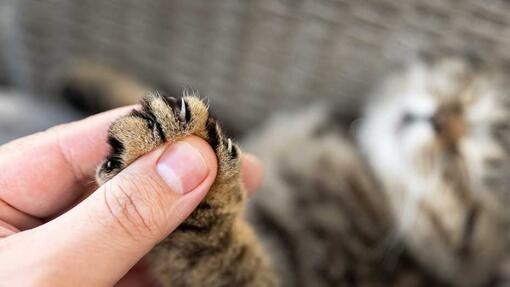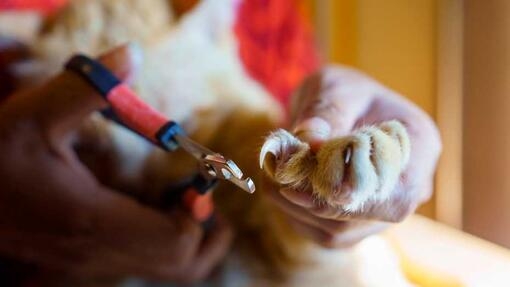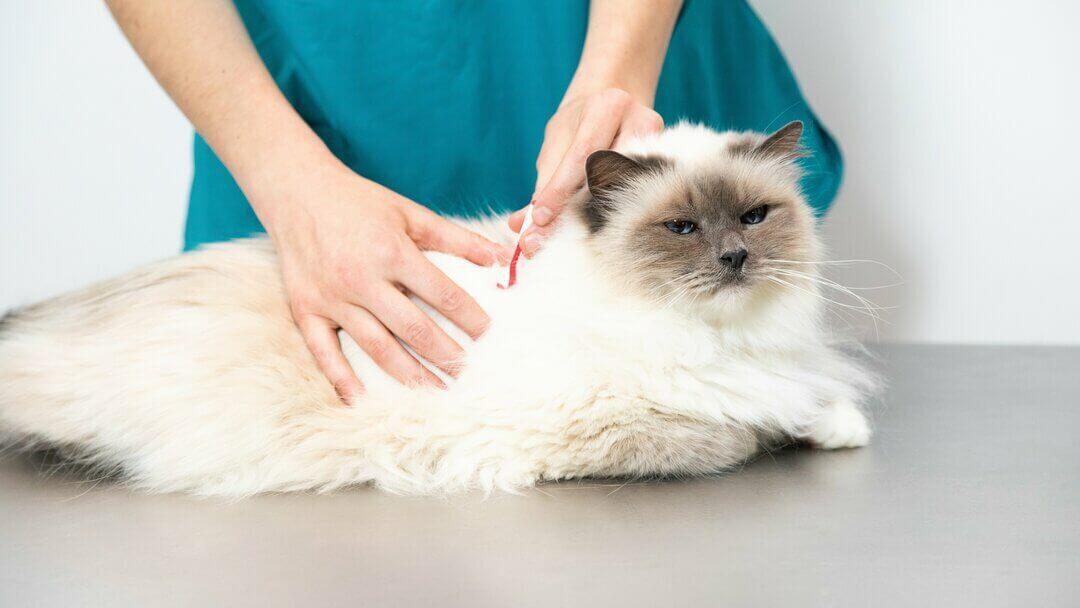
Cats’ claws grow just like our nails, so you might be wondering if you need to trim them when they get too long. This can seem like a daunting task, but it is possible to make it stress-free for you and your feline. Keep reading to discover our top tips for how to trim your cat’s nails.
Do I need to trim my cat’s nails?
Knowing whether you need to trim your cat’s nails depends on their lifestyle and age. Active, outdoor cats and kittens may not need their nails trimming as their nails will naturally file down. For these cats, trimming could leave them less able to grip onto things to climb or escape from danger.
Indoor and/or older cats are more likely to have longer claws so they might need to be trimmed.
However, all cats will need a place to scratch, so it’s important to have this space in your home. We have a guide on finding the perfect scratch post here.
If untrimmed, a cat’s nails can end up being uncomfortable. They could get caught in things, like carpets or their cat beds, which pull on their nails! Cat’s nails are also curved, so if they’re too long, they can curl into their paw pads and potentially cause cuts, pain and infection.
If this is the case, contact your vet for guidance and help. They will provide your cat with a treatment plan.
How do I know if my cat’s nails need trimming?
There are a few tell-tale signs you can look out for to know if your cat’s nails need trimming. These could be:
- Your cat keeps getting caught in things, like carpets, blankets, or their beds
- They’re not scratching on their scratch posts properly because their nails are too long and it hurts to do so
- You can hear your cat’s nails tapping on hard floors when they walk
- You can see the whites of their nails on their paws when they’re resting
It’s important to keep an eye on your cat’s nails so you can make sure they’re at their most comfortable and ensure there are no potential issues. Even if most of their claws look fine, if your cat is older or lives indoors you should regularly check their dew claws (the one on each side that’s higher up on the inside of their front legs), as this commonly overgrows and causes pain. If you’re ever concerned about your cat’s nail health, contact your vet.
How to trim cat nails: step-by-step guide
Cutting your cat’s nails can be a daunting task – we know that many cats are not a big fan of this process. We’ve created a guide below to make this as stress-free as possible, for you and your cat. Take a read below.
Early preparation
Many cats do not like having their paws touched so if you have an indoor cat or a cat you think may need their nails trimmed in the future, it is important to teach then that this can be enjoyable long before you need to trim their nails. This will reduce stress levels all round and make nail clipping far easier for you both.
When you are sitting quietly with your cat and stroking them, begin slowly stroking your hands down the top of their legs. Don’t go far and never more than they are happy with. After a few strokes, go back to stroking or scratching the bits you know they love.
As long as they are happy about this, you can maybe go a bit further and build this up until you can stroke down their leg. Don’t rush this (it is more likely to take weeks or even months – than hours!), don't do any more than two leg strokes in a session (as it can just get too intense for your cat), use treats for each stroke as a reward if your cat is a foodie, and go at your cat’s pace.
Once you can do that, you can begin to introduce some gentle paw touches – and even light massage if your cat enjoys it.
The secret is go slowly! Your aim is always to keep within your cat’s comfort zone and not produce a ‘get off’ response! Always stop before they get uncomfortable or try to pull their paw away.
1. Prepare to cut your cat’s nails with the right equipment
It’s important to get the correct cat nail scissors. Using human nail clippers is not advised. Cat nails are made up of thin sheets. Using human nail clippers will cause the nails to break off and splinter which can lead to damage to their nails. Cat nail scissors have the right shape to cut a cat’s nails to prevent this from happening.
Another thing to prepare is their favourite cat treats! Teaching your cat that cutting their nails is a pleasant experience is a great idea.
Lastly, you may want to grab a blanket or towel and close the doors, so your cat doesn’t escape. This might even be a two-person job the first few times so bear this in mind.
2. Make sure your cat is calm and comfortable
It’s probably best to not try and trim their nails when they have the cat zoomies! Make sure your cat has a calm demeanour and find a comfortable spot to hold them in. You will have to make sure they’re securely held at the same time.
3. Hold their paw gently but firmly
Once they’re securely held, gently grab their paws. Softly push their toe between your finger and thumb to reveal their nail. Make sure to not squeeze their toes as this will be uncomfortable. If your cat isn’t used to their paws being handled, you may want to familiarise them with this step before trying to cut their nails.
4. Trim the tip of their nail
This bit is really important so as to not cause your cat any pain. Trim the tip of their claw, avoiding the pink bit of their nail that’s located closest to their nail bed. This part of the nail is called the quick and is made up of sensitive tissue containing blood vessels and nerves – cutting it will be painful for your cat and cause them to bleed.
Note: if you accidentally trim your cat’s nail slightly too short, apply firm but gentle pressure with a paper towel or some cotton wool for up to 5 minutes to stem any bleeding. If there’s significant bleeding, it won’t stop or your cat seems very distressed, you should contact your vet for advice.
5. Give your cat a well-deserved treat!
It’s a good idea to give your cat a treat after each paw. This can be a stressful process so giving them a treat can help them to understand that this is a positive experience.
6. Pay attention to your cat’s body language
Keep an eye on your cat’s body language to see if they’re distressed. If this is the case, take a break and come back to the task later or even the next day.
Note: while many cats have become accustomed to regular nail trims with no issues, some cats will not tolerate their nails being trimmed at home. If this is the case, your vet should be able to help. If your cat does become distressed, it’s important to back off and avoid the possibility of getting bitten. If you are bitten, you should contact your doctor urgently.
We hope this guide on how to trim a cat’s nails was helpful! This task can be a bit daunting for both you and your cat, but practice and patience make perfect. Next, for information on cat grooming, see our article on how to clean cat ears. Or, for more for more helpful daily cat care tips, see our guide on how to give a cat a pill.










